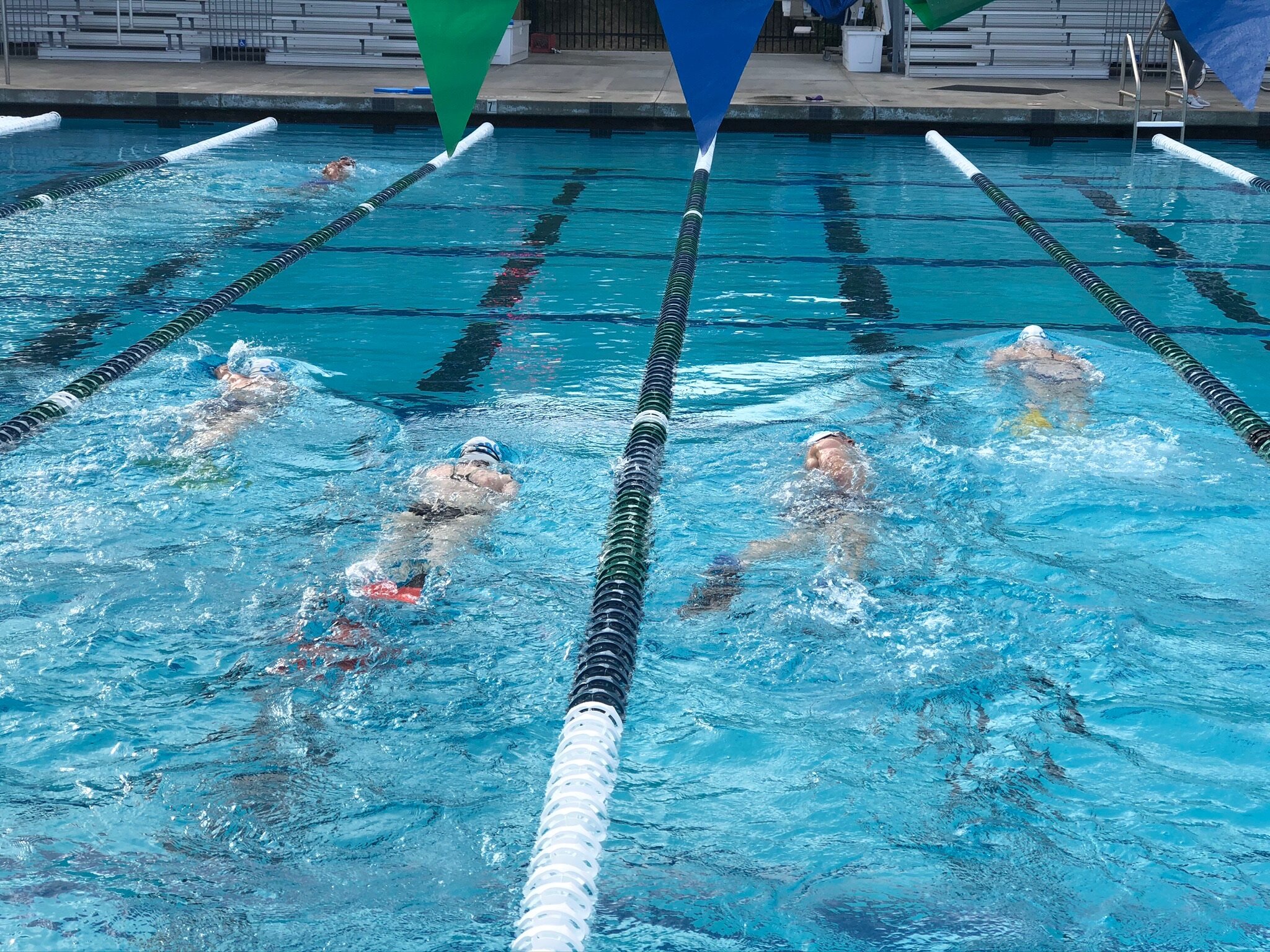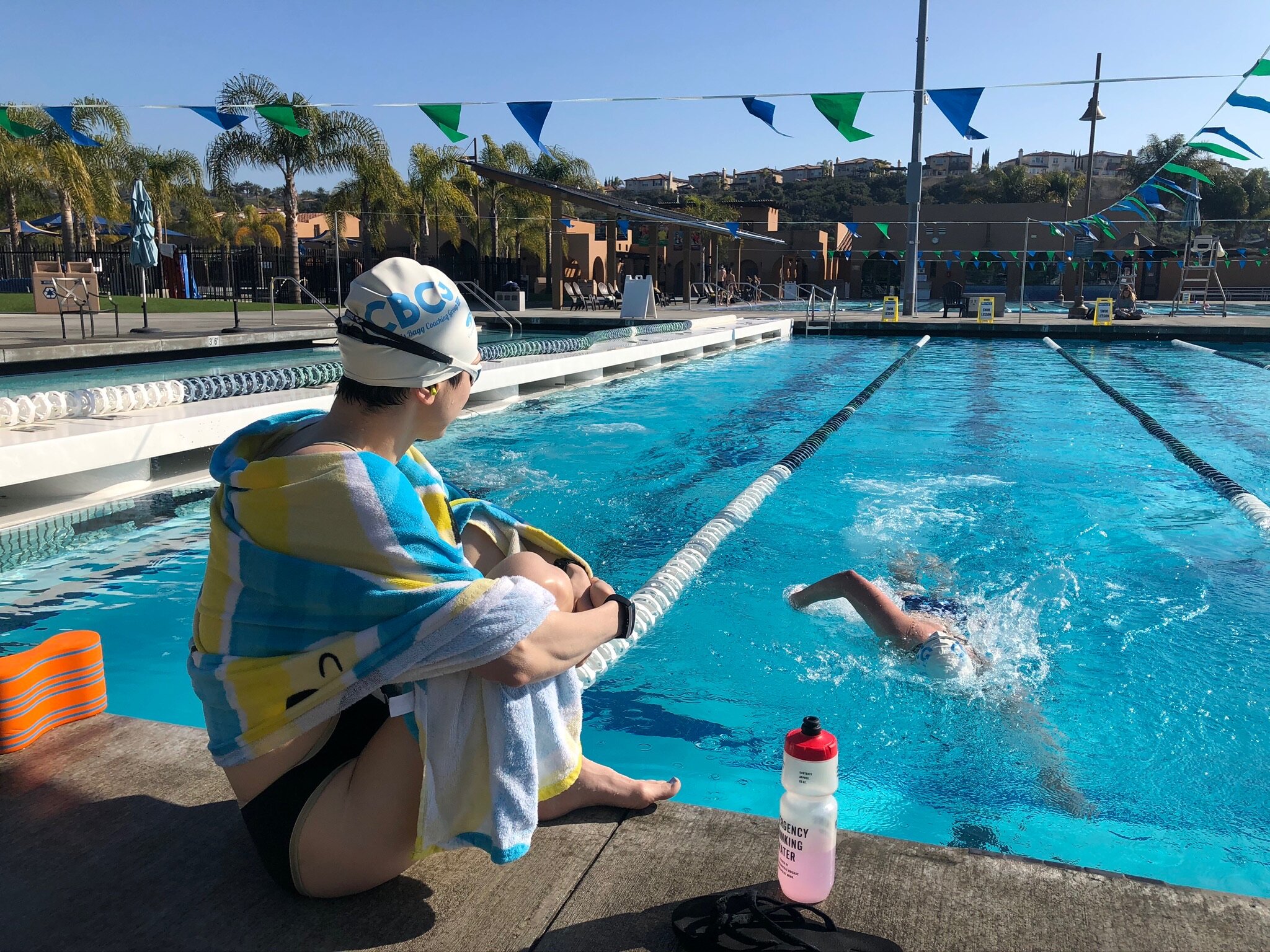Early Season Swim Development: Go LONGER, Not Faster
by Chris Bagg and Molly Balfe, Head Coaches
If you’re a triathlete but swim with a Masters-style swim team, you may find the following set familiar, as your coach narrates it from the deck: “OK, everybody! Great warmup. Next up we’re gonna do a set of 10x100, followed by 10x50s. Lanes one and two, that’s on a 1:30 send-off base. Lanes three and four, you guys are on a 1:40 base. Five and six, swim those on a 2:00 base.” Setting aside all the “send-off” talk, this main set looks a lot like what the coach (and the swimmers next to you) experienced when they swam in high school: short intervals, usually swum as fast as possible, with the limiting factor traffic rather than any of the athletes’ abilities (if you start deploying intervals longer than 200s, for instance, the swimmers at the front of the group often start to catch the tail of the group, and then no one is happy).
You’re a triathlete, though, or a longer-distance open water swimmer, and the set above, while perfectly fine as a pool swimmer’s set, isn’t specific to your needs as an athlete. The shortest triathlon swim leg is still a “distance” event, in swimming terms, and your preparation should mirror the demands of the event. Swim Smooth, of course, has been tackling this problem for years, with their “Red Mist” workouts: longer intervals (in some cases up to 1000 yards or meters per interval) with relatively short rest. To make an analogy with running or cycling training, these are “sweet spot” style intervals, or a little bit below threshold effort/pace/power/HR, and they build a base that allows you to place speed on top of it.
Speaking of speed, the usual Swim Smooth system for developing it comes from establishing your swim threshold (critical swimming speed or “CSS”) and then slightly increasing the speed every week over a ten week period. To continue the cycling or running analogy, you would find your threshold power or pace and then—each week—aim for slightly higher or faster intervals each progressive week. Take the bike, for example. Maybe one week your coach assigns you 4x8’ intervals at your threshold of 250w. The following week you’d do 4x8’ at 255w, and then 260, and so on. For running you’d slowly creep up your interval paces, and after a training block (10-12 weeks, for Swim Smooth’s Ten-Week CSS Challenge), ostensibly you’d have a new, higher threshold.
Unfortunately, the physiology doesn’t quite hold up. Doing any kind of work at threshold is a very aerobic affair—in fact, threshold is often defined as “an athlete’s fastest sustainable aerobic pace or effort.” Developing the aerobic system takes time, because you need to build new capillaries to exchange more oxygen, create new mitochondria in your cells to power more respiration, and teach your system to oxidize more fat. If you simply try to speed up, you’ll actually be working above your threshold, missing the intensity that will improve your aerobic abilities. At CBCG, we’ve shifted our approach on the bike and run to one where athletes try to extend their time at threshold (lengthening) before entering an intensive (raising) period. We’ve come up with a system for the pool, and we’re going to share it with you today.
Firstly, though, we’d like to say that we’re firm believers in the Swim Smooth method, and this approach wouldn’t even be possible without their thinking and their established framework. We hope you (and they!) see it as a sensible addition to their program—not a swerve away from it.
OK, disclaimers and caveats aside, here’s what we often hear from athletes after they complete their CSS test and find their threshold pace: “I’m happy with that number, but there’s no way I could hold that number for 1500 meters.” Swim Smooth knows this, and has pointed out that knowing your threshold pace isn’t a perfect predictor, but it gives us a number from which to build training. Functional Threshold Power (FTP) is similar on the bike—on any given day, due to fatigue, fueling, sleep, or any other factor, you may see your FTP swing up or down 20 watts! So the testing system isn’t perfect, and it never will be. These numbers simply give us a way to prescribe training, but we believed that we could improve athletes’ fitness by first improving their ability to swim longer at CSS, rather than instantly jumping into swimming faster. Here’s how it works.
Test your CSS: no real changes on this step. Just as you would with our normal swim test (Swim Smooth’s classic test) you’re going to warm up well and then perform two time trials: a 400 as fast as you can go (ideally without slowing down or blowing up), about five-to-eight minutes of easy swimming, and then a 200 as fast as you can go. Once you’ve got those numbers, enter them into this calculator here to find your threshold pace. Remember, this is a decoupling test, so it measures how much you slow down from the shorter distance (200) to the longer (400) and then extrapolates. So if your 200 is much faster than your 400 in terms of pace per 100, the test figures you don’t have much endurance, and adjusts your CSS down. Let’s say you end up with a CSS of 1:40/100.
Then, after you’ve given yourself a few days, you’re going to see just how long you can hold 1:40/100 for. Ideally you’d use a Tempo Trainer for this set, but if you don’t have one you can also simply eyeball your local pace clock. The magic of the tempo trainer is that you’ll know exactly when you fall off the pace. We tell our athletes that they can fight back to try and get back up to the beep of the tempo trainer, but once they’re falling behind it’s time to call it. Let’s say that you hold 1:40 for 700 yards, but then have to slow down. Your Distance to Exhaustion (or DTE) is 700 yards.
Now you’ll figure out where to pick up weekly extensive progression, finding the main set that is just slightly beyond your DTE. For all of these sessions, we suggest about 800-1500 of warmup and drills before tackling the main set, and then some cooling down afterward. All of these sets should be done with minimal rest, probably ten seconds in between intervals for the shorter ones (200 and below) and 15-20 seconds for the longer ones (300 and up)
Week one: 6x100
Week two: 5x150
Week three: 4x200
Week four: 6x150
Week five: 3x300
Week six: 5x200
Week seven: 2x500 (this is a tough one—you can change it to 4x250 if 500 still feels too long at CSS, although it shouldn’t by now…)
Week eight: 3x400
Week nine: 9x150
Week ten: 4x350
Week eleven: 3x500
Week twelve: 2x750
Week thirteen: 1x1500
Whew! Congratulations. That’s a big swim in week 13! If you’ve been doing these sessions each week (or twice a week, which is an acceptable adjustment of the plan) the 1500 should actually feel pretty doable, however. Your body needs fewer adaptations to support longer than it does to support faster.
Now that you can swim your CSS for 1500, though, now is the time to go faster. We suggest you pick up with the Swim Smooth Ten Week CSS Challenge, since you’ve built a robust and enduring aerobic system. You’ve baked your cake, and now it’s time to frost it!





